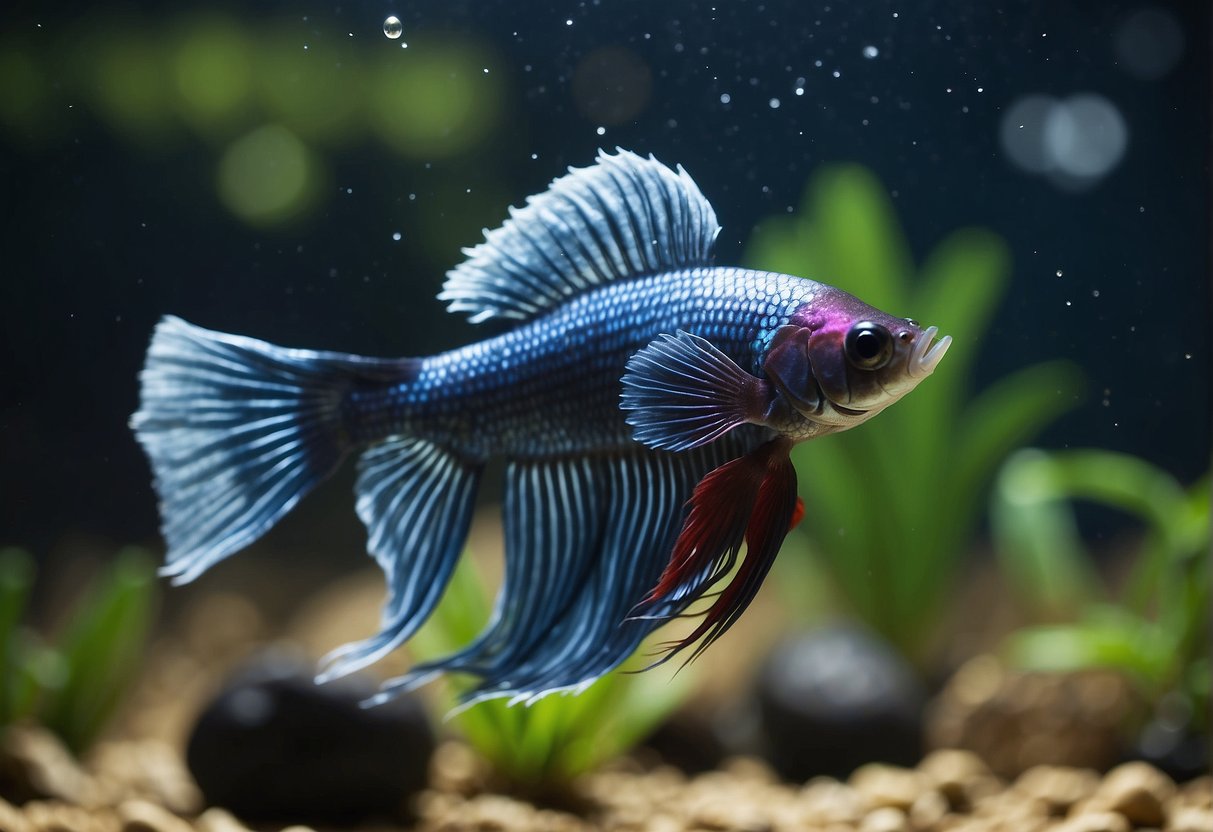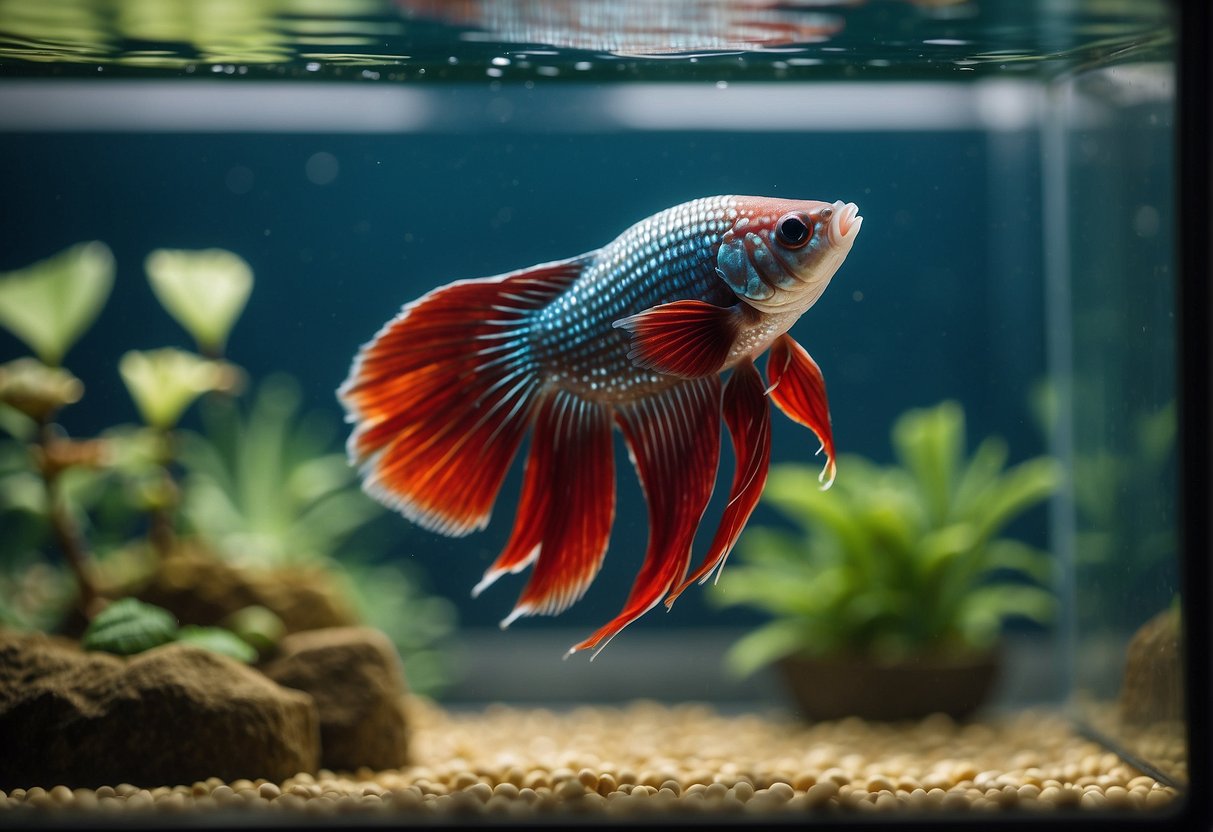A happy betta fish makes a happy aquarium. While that may sound a tad chuckle-worthy, it’s still very true. As an avid aquarist, I’ve always been fascinated with fish behaviors and ensuring that the fish in my aquarium are in good spirits.

Fish have moods, and their behavior often reflects those — an important fact to keep in mind, especially if you want a sustainable relationship between your fish and its tankmates. Bettas, in particular, are pretty interesting fish, showcasing distinct patterns and actions when they are content and also when they’re not.
Knowing whether my betta fish is happy and thriving is crucial, as it’s a good indicator of their well-being and a successful and harmonious aquarium environment. So, without wasting time, let’s talk about bettas, their moods and behaviors, and how to make them happy.
Contents
Species Overview
Betta fish are some of the most vibrant examples of aquatic beauty, mainly due to their world-famous, exquisite finnage and array of colors. It’s little wonder that they are such favorites among aquarists.
Dietarily, betta fish are obligate carnivores, requiring a diet rich in protein; behaviorally, they are solitary creatures, which means they thrive best when housed alone. They are also very territorial fish with strong territorial instincts.
Natural Habitat and Behaviors
Betta fish are naturally found in warm, shallow waters, typically rice paddies, ponds, and slow-moving streams in regions like Thailand (which, fun fact, has more rice paddies than almost every other country). Replicating this environment in an aquarium requires water at the same temperature and pH levels ranging from soft to slightly acidic.
Behaviorally, betta fish are among the most amazing fish to watch. Their tendencies are quite complex, from being active and exploring their environment to lying on plant leaves or tucking into a suitable hideaway. They also do interesting stuff like building bubble nests in preparation for spawning—a good indicator that they’re comfortable in their environment.
Creating a Supportive Environment

To ensure your betta fish thrives, you must focus on creating an optimal environment that meets its specific needs. From the size of the tank to the quality of the water and the selection of decorations, each aspect plays a crucial role in making a happy and healthy betta.
Tank Requirements
The tank contains the betta’s entire ecosystem, so the right tank specifications will greatly impact the suitability of said ecosystem.
Tank Size: When selecting a tank for your betta fish, you should consider one that is at least 5 gallons. Tanks that size (or bigger) provide ample space for swimming and exploring. A larger space minimizes your betta’s stress and allows you to manage the water parameters better.
Shape: Tall and narrow tanks are a no-no for any fish the size of a betta (and even many smaller species). Bettas prefer to swim horizontally and need easy access to the water surface for air, so a broader tank is generally best.
Water Quality and Conditions
After ensuring the right tank size, the water you put in it is next to consider.
Temperature: Maintaining a consistent water temperature between 76°F and 80°F is key for a betta’s comfort, as they are tropical fish and are very sensitive to temperature fluctuations.
pH Levels: The ideal pH level in a betta tank should be around 7.0. You can monitor it with a reliable test kit to ensure it is and stays that way.
Water Change: Partial water changes of about 20-30% bi-weekly will suffice to keep the water clean and your betta healthy.
Appropriate Decorations and Plants
Just as you enjoy an environment with cute things and explorable areas, betta fish also enjoy such things of interest. In this regard, the following are crucial.
Live Plants: Incorporating live plants like Anubias and Java Fern in your betta tank adds beauty, oxygen, and hiding spots, closely replicating the betta’s natural environment.
Decorations: Smooth-edged decorations serve as additional hiding spaces and play areas without risking fin damage. You should ensure all decorations are betta-safe with no sharp edges.
Signs of a Happy Betta Fish
Given how vital a betta fish’s happiness is to its flourishing in its environment, how do you determine that it is, in fact, happy?
Physical Appearance
Your first indicator that your betta fish is having a good time is its physical appearance.
Vibrant Color: When happy and healthy, betta fish display bright and vibrant coloration. Dullness or discoloration can be a cause for concern, suggesting stress or illness.
Fins: If your betta fish’s fins are full and flowing without tears or ragged edges, it indicates health and, almost certainly, a positive mental state.
Behavioral Indicators
Physical indicators can tell you quite a bit about your betta’s mental state, but the best way to gauge said state is through the behaviors you observe.
Active Swimming: A Betta that is actively exploring its environment and gracefully swimming across the tank is likely joyful. By contrast, if you notice lethargic behavior or a lack of movement, these could indicate an issue.
Bubble Nests: When your Betta constructs bubble nests, it’s a natural behavior linked to breeding readiness and a clear indicator that it feels secure and happy in its tank.
Feeding and Nutrition
As an aquarist, you must learn the importance of proper feeding and nutrition for your fish’s happiness and health. It shouldn’t be surprising that your fish is happier when they chow great than when they don’t.
It’s also possible to tell how happy your betta fish is by their feeding behavior. So, in this section, we will discuss what constitutes a balanced diet for these vibrant fish and how their feeding behavior can signal their well-being.
Dietary Needs
Betta fish thrive on a diet that’s both rich in protein and diverse. Live or frozen foods, such as brine shrimp, contribute to a significant portion of an aquarium betta’s diet. These foods mimic their natural eating habits, ensuring they get sufficient nutrients.
To balance things a little, you can always add high-quality pellets formulated explicitly for bettas; these pellets typically contain the necessary vitamins and minerals. Overfeeding can be an issue, so prevent that and other potential health issues by giving the betta a measured amount—about the size of their eye—once or twice daily.
Feeding Behaviors

Observing your betta during feeding time can give you much insight into its state of mind. A happy betta exhibits an active appetite; they enthusiastically approach their food and wolf it down at once.
A happy betta will often swim to the surface when you approach, anticipating feeding. This behavior reflects both their comfort with their environment and their association of your presence with the positive experience of eating. When feeding your betta, you should watch for this eagerness to eat.
Naturally, betta fish won’t always be eager eaters, and lack of enthusiasm for food may not always mean they are unhappy. For example, it may just mean they are full, and you’ve been spoiling them too much.
On days when your betta seems hesitant or disinterested in food, you should watch for any additional signs that might indicate stress or illness, such as an abnormal physical appearance or a general sluggishness throughout the day.
Social Interactions and Tank Mates
There is a social dimension to a betta fish’s life. As such, you want to understand the cohabitation dynamics between your bettas and other tank mates, as it factors into the overall health and well-being of your aquarium. After all, no one is happy with lousy neighbors who don’t know their lane, not even betta fish.
Betta Fish and Company
Contrary to what some might think, especially due to Betta fish’s highly territorial nature, these animals have thresholds for social interactions. In an aquarium, you can observe that your betta prefers to be the star of the show.
As such, if any potential tankmate is as flashy and territorial as the betta, he will have war. It, therefore, is vital to ensure harmony by introducing tankmates who know to stay in their lane, preferably a smaller lane than the bettas.
Some aquarium enthusiasts suggest guppies as tank mates, but in my experience, the similar appearance between male guppies and Betta fish can cause tension due to their bright colors and flowing fins. Bettas might misidentify the guppies as rivals and behave aggressively towards them.
Choosing Compatible Tank Mates
When selecting a tankmate for your Betta, you should focus on peaceful species occupying different tank layers. Mid to bottom dwellers, such as Corydoras Catfish, are excellent companions; their peaceful nature and bottom-dwelling habits steer clear of the Betta’s domain. Other options include the following:
- Neon Tetras: Small and nimble, Neon Tetras can be suitable companions, but with caution. They are peaceful but fast swimmers and should be kept in a school to avoid nipping at your Betta’s fins.
- Snails: Many snail species are harmless to Bettas and can share the space without drama. Snails also contribute to the cleanup crew of your tank, which is an added bonus.
In essence, you should look for peaceful, non-territorial species that keep to themselves, thus allowing your Betta to remain the calm and happy ruler of its little aquatic kingdom.
Health and Well-being
We’ve mentioned that a betta fish’s happiness is often a reflection of its health and environment. In this section, let’s explore betta health and happiness and how to ensure the latter through the former. In my experience, a betta fish’s happiness is often a reflection of its health and environment.
I’ll guide you through recognizing when your betta may be under stress or showing signs of illness, and how maintaining proper care ensures their well-being.
Recognizing Signs of Stress and Illness
When assessing a betta’s health, behavioral and physical indicators are key. You know your betta is stressed when it hides a lot of swims erratically. Health concerns become apparent from physical and behavioral indicators as well. For instance, signs of ick, a common parasitic condition, include white spots on the body and fins.
Maintaining Health through Care
Optimal care should be your priority to ensure your betta fish’s health and, by extension, happiness. This involves following a consistent routine of correct feeding, water changes, and tank maintenance to shield them from stress and illness.
- Conduct regular water changes and use a quality water conditioner.
- Keep the water temperature between 76-82°F (24-28°C), implementing a heater if necessary.
- Provide a balanced diet with a variety of nutritionally adequate foods
On the whole, your betta fish’s happiness is tied to providing excellent care and quickly addressing stress or illness signs.
Frequently Asked Questions

I’ve scoured the internet and found some common questions about betta fish contentment. Here are my answers based on my experience as a long-time aquarist.
What signs indicate that a betta fish is content in its environment?
A content betta fish will exhibit active swimming patterns and will display vibrant colors that can be dazzling, almost metallic in appearance.
What behaviors suggest a betta fish is forming a bond with its owner?
A betta fish bonding with its owner may come up to greet you when you’re near the tank or follow your movements through the glass. These actions suggest recognition and a level of trust.
How can one differentiate between a stressed and a relaxed betta fish?
Stress in betta fish can show itself through dull colors and clamped fins, while a relaxed betta will have bright colors and fins that are flared open, signaling comfort and health.
In what ways can an owner improve the well-being of their betta fish?
Ensuring the tank is at a proper temperature, usually between 75° – 84° F, and maintaining clean water conditions are fundamental. Also, providing enrichment like plants or toys can significantly enhance their well-being.
How can you distinguish between a healthy betta fish and one that is not?
A healthy betta fish will have bright colors and be free of parasites or diseases, whereas an unhealthy one might show signs of fin rot, white spots, or lethargy, indicating it’s time for closer attention or a visit to the vet.
What are typical behaviors exhibited by a betta fish under normal conditions?
Under normal conditions, betta fish will be active and alert, exploring their environment and showing curiosity towards anything they notice. They’ll also eagerly eat during feeding times and interact gently with tank mates if they are present.

Ian Sterling, founder of Fishlab.com, began his aquarium journey over 30 years ago, driven by a deep fascination for fish and their diverse personalities. His website, Fishlab.com, is dedicated to making fishkeeping accessible and enjoyable, offering beginner-friendly guidance, expert insights, and a community for aquarists to connect and share experiences.


